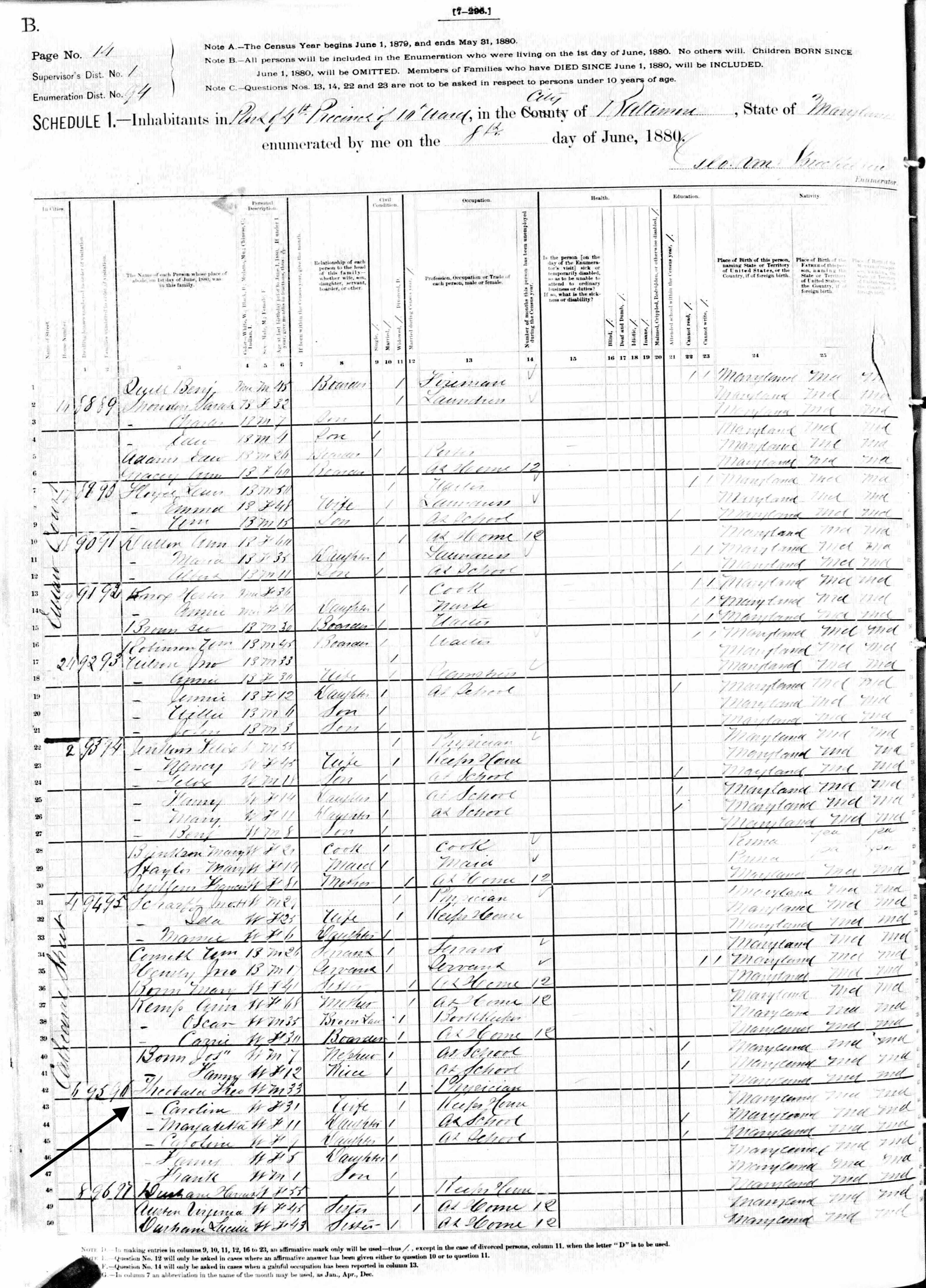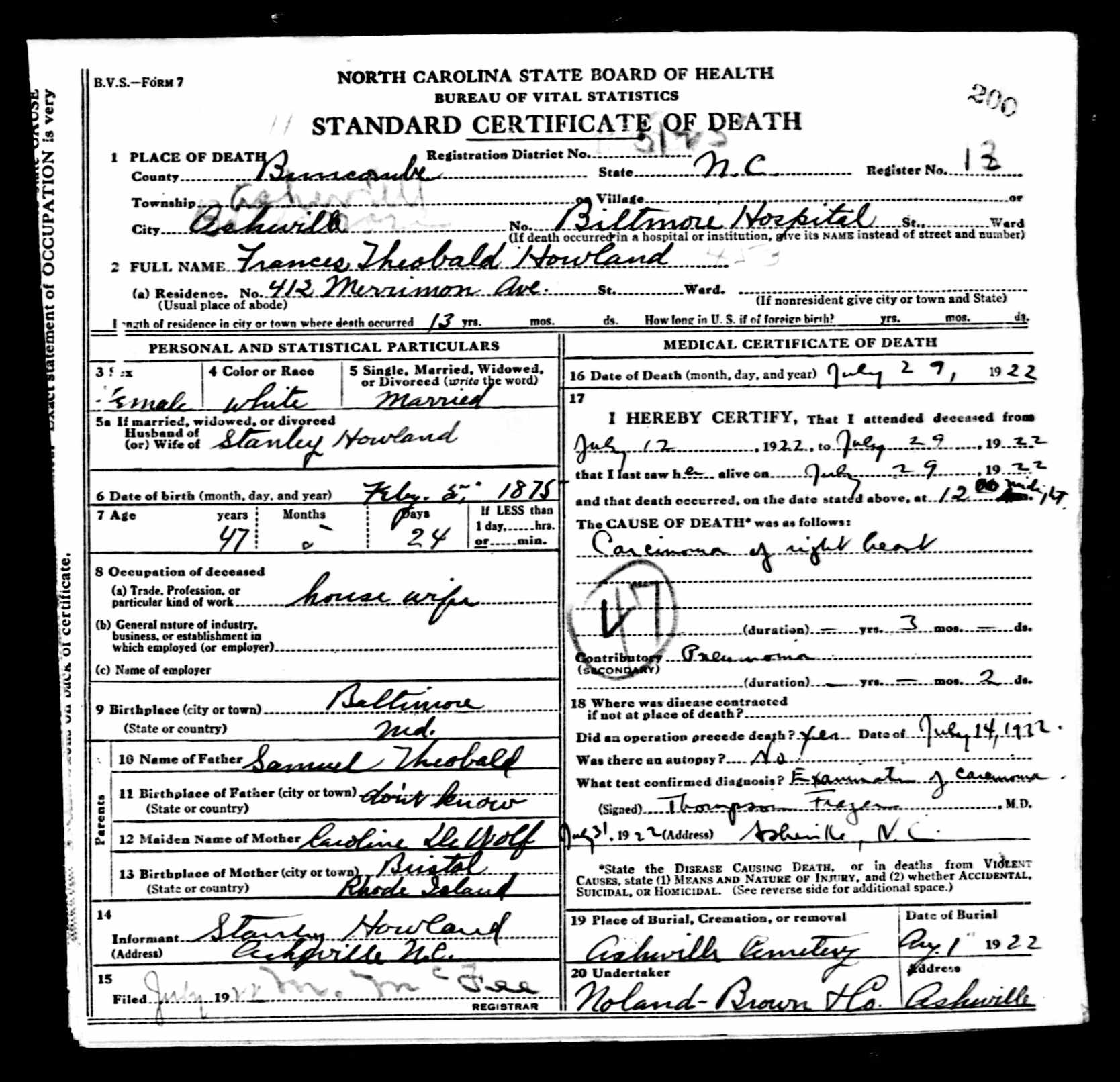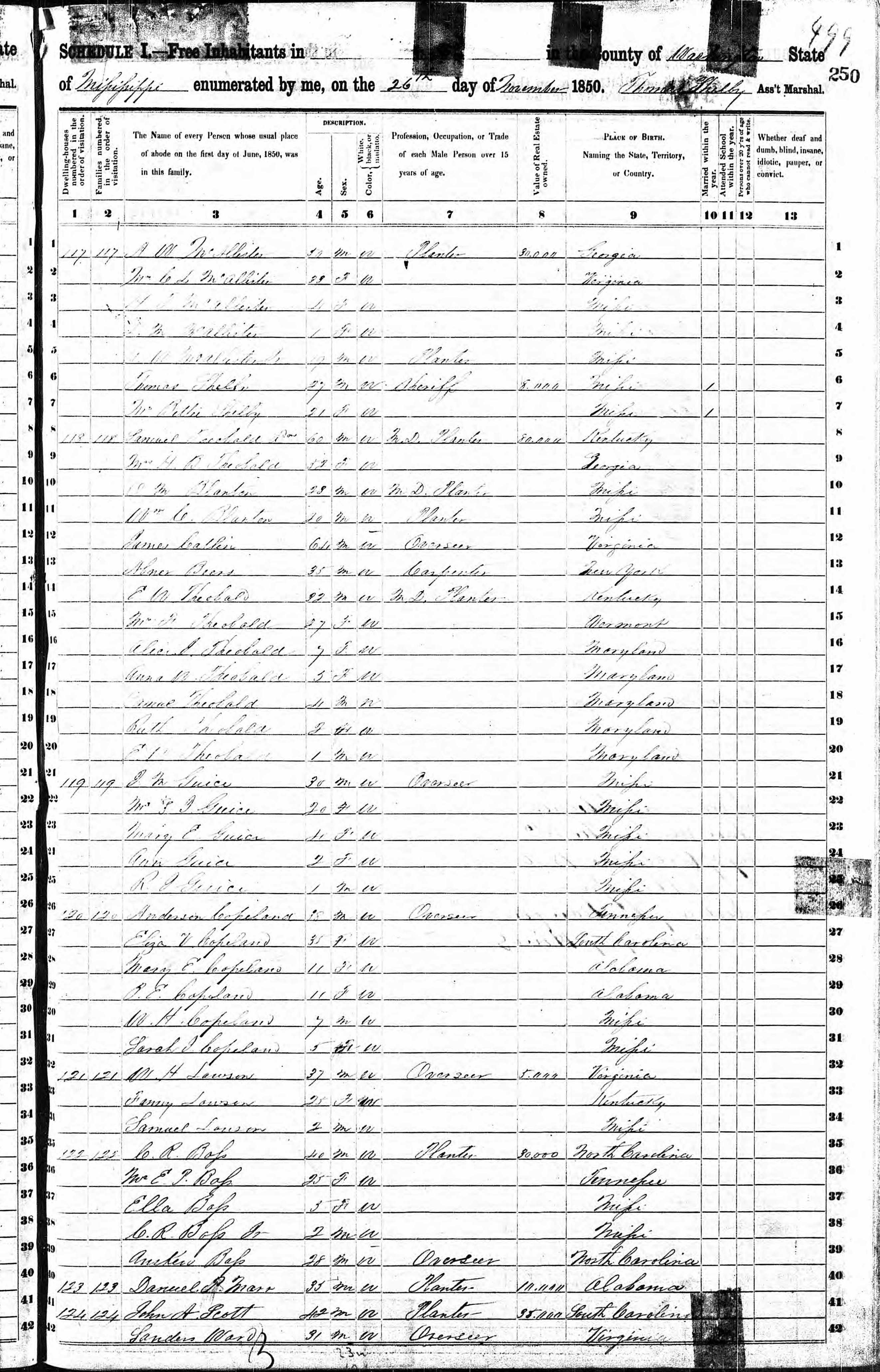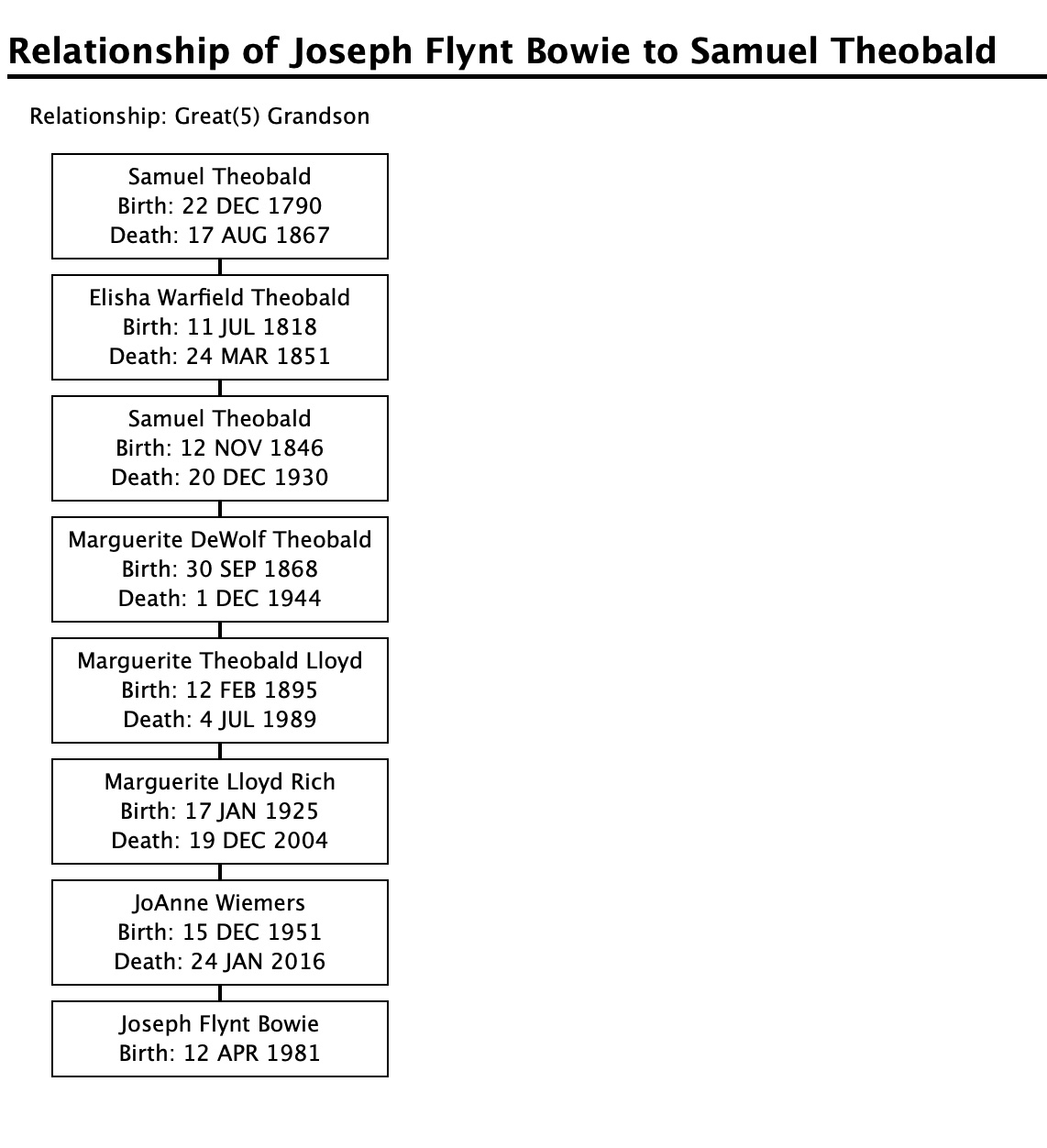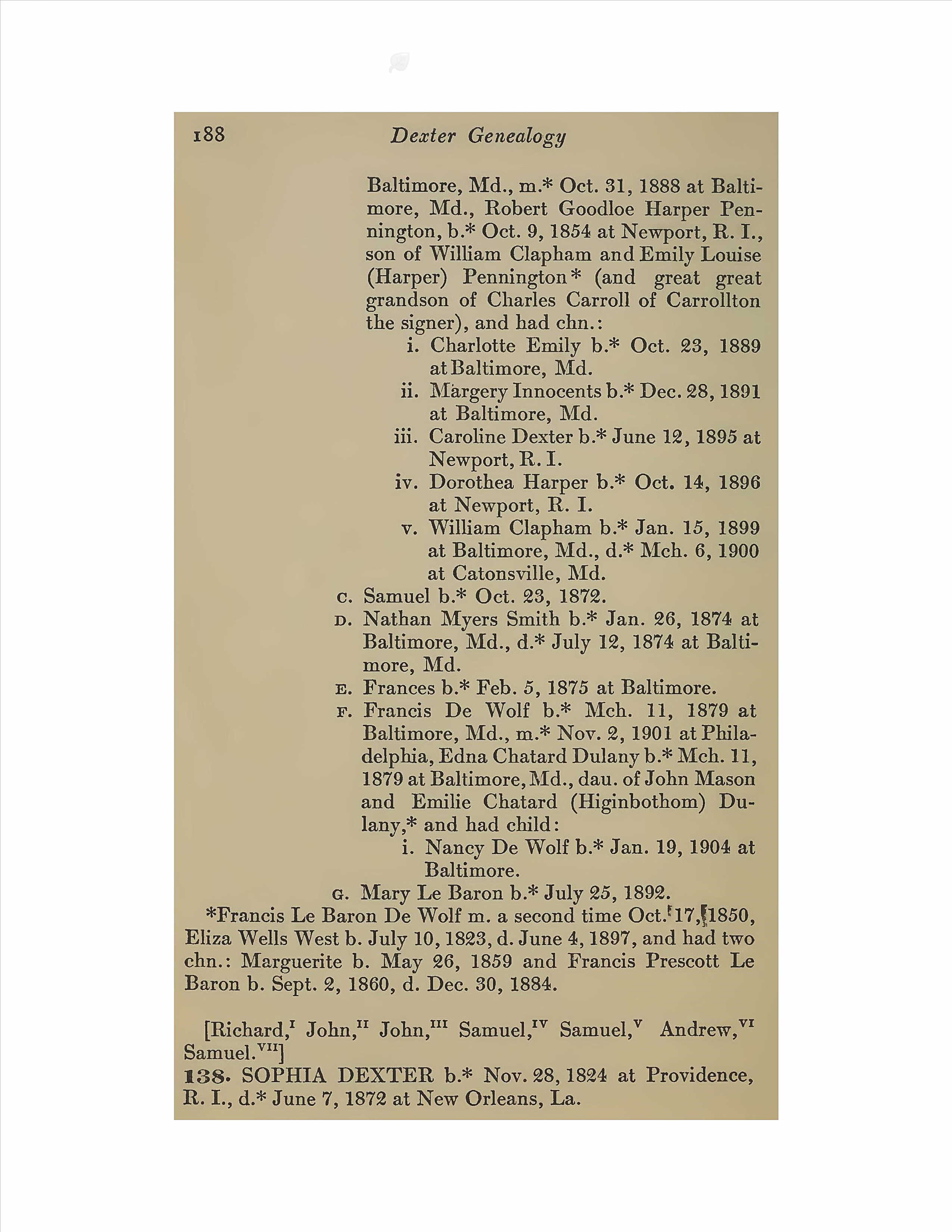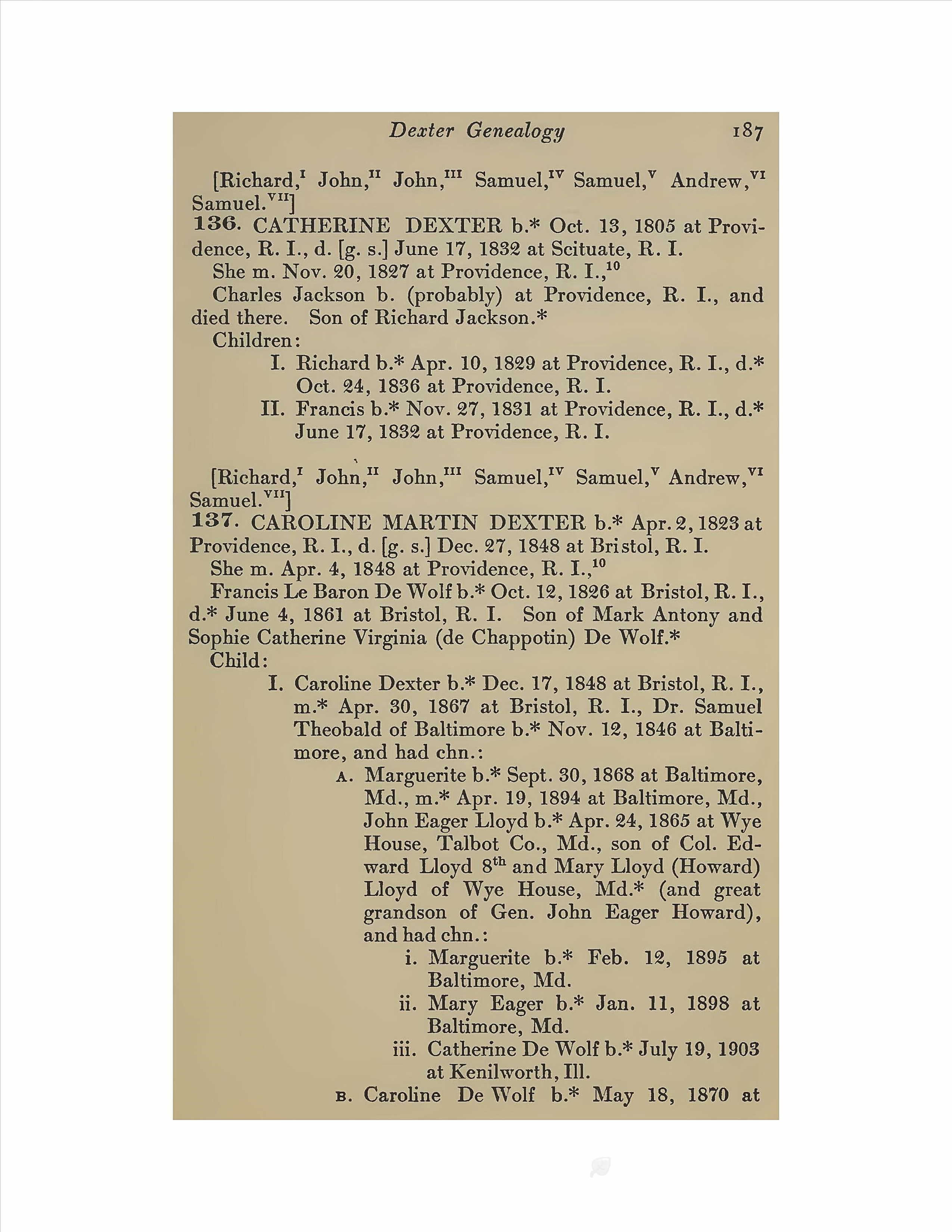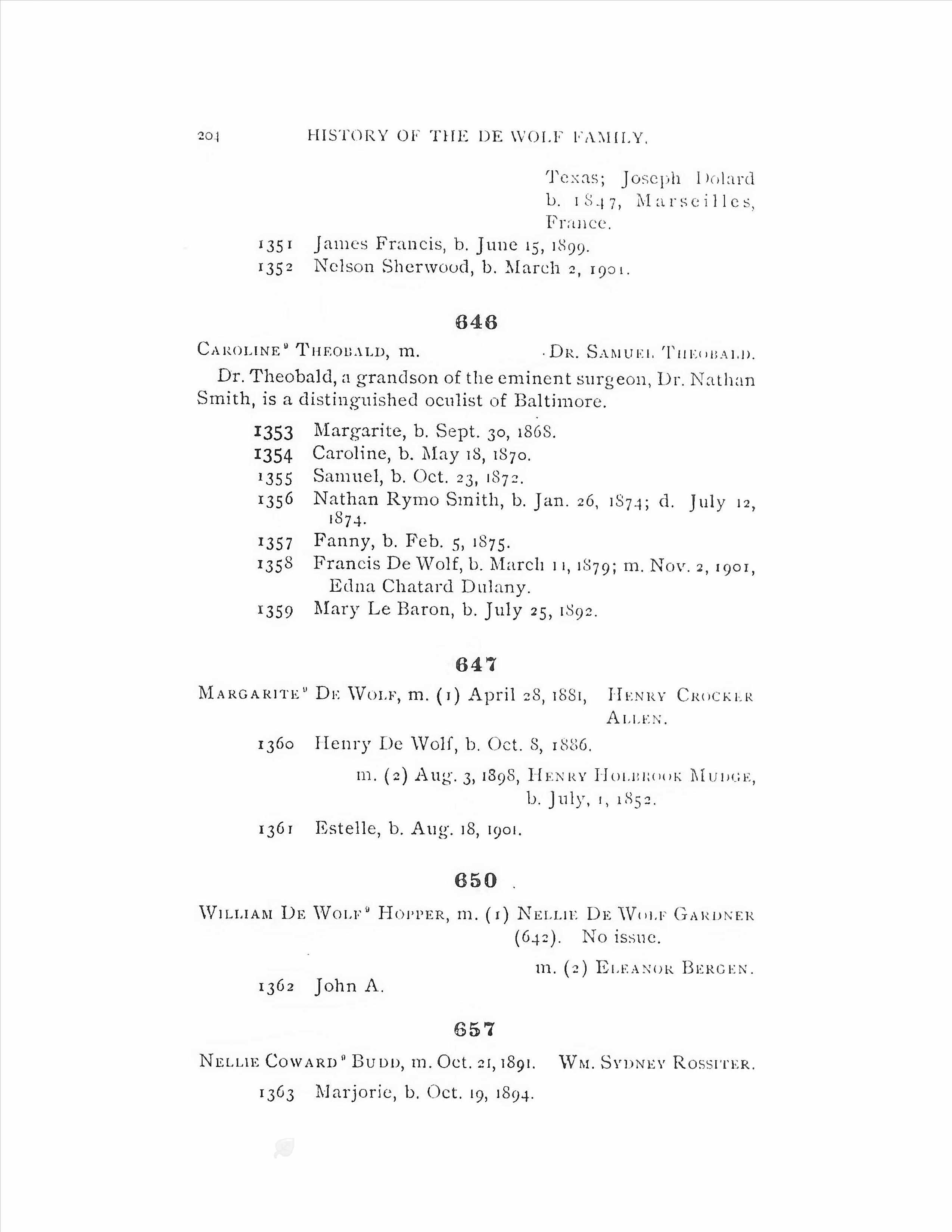Samuel Theobald
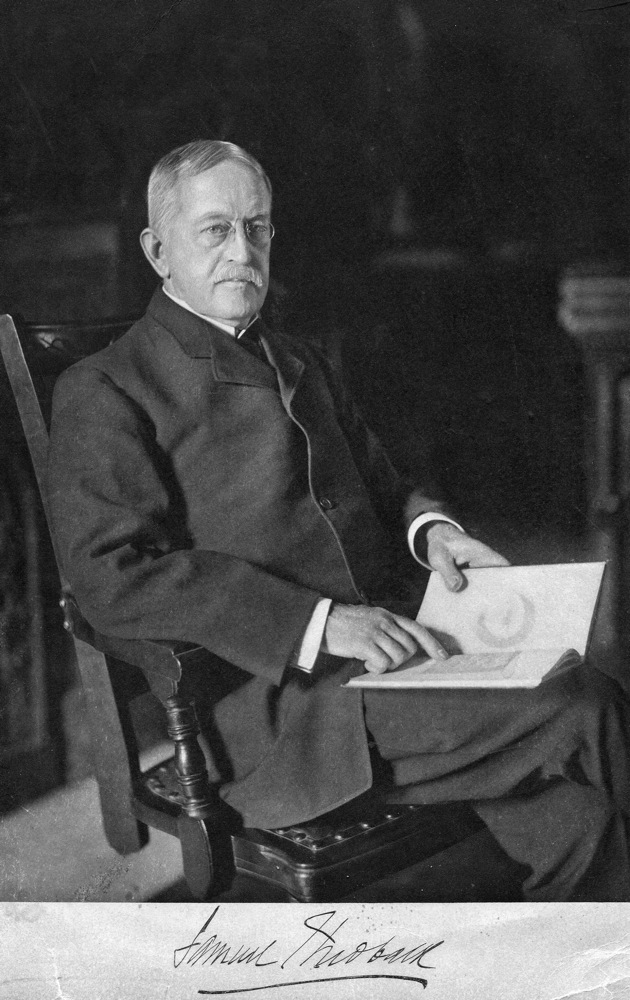
Personal and Family Information
Samuel was born on 12 NOV 1846 in Baltimore, Maryland, the son of Elisha Warfield Theobald and Sarah Francis Smith.
He died on 20 DEC 1930 in Baltimore, Maryland.
His wife was Caroline Dexter DeWolf, who he married on 30 APR 1867 in Bristol, Bristol Cty, Rhode Island. Their seven known children were Marguerite DeWolf (1868-1944), Caroline DeWolf (1870-1962), Samuel Jr (1872-1956), Nathan Rymo Smith (1874-1874), Frances (1875-1922), Francis DeWolf (1880-1930) and Mary LeBaron (1892-1917).
Pedigree Chart (3 generations)
Events
| Event | Date | Details | Source | Multimedia | Notes |
|---|
| Birth | 12 NOV 1846 |
| Place: | Baltimore, Maryland |
| Address: | gravestone and Christening index have Nov12, 1846, 1900 census Md has Dec 1847
|
|
|
|
|
| Death | 20 DEC 1930 |
| Place: | Baltimore, Maryland |
| Age: | 84 |
|
|
|
|
| Christening | 28 SEP 1848 |
| Place: | Christ Church Parrish, Virginia |
| Age: | 1 yr |
| Address: | Chase and St Paul Street, Baltimore, Maryland |
|
|
|
See Note 4 |
| Census | 16 SEP 1850 |
| Place: | Baltimore, Maryland |
| Age: | 3 b Maryland |
| Address: | 11 Ward, dwelling 344, family 381
with parents, 3 siblings, 4 servants |
| Agency: | 1850 census Maryland |
|
|
|
See Note 2 |
| Census | 26 NOV 1850 |
| Place: | Washington County, Mississippi |
| Age: | 4 |
| Address: | dwelling 118, family 118
Samuel Theobald Dr?, age 60 mw, M.D. Planter, $80,000, born Kentucky
Mrs H. B. Theoblad, age 52, fw, born Georgia
O.M. Blanton, age 28 mw M.D. Planter, born Miss
Wm C Blanton, age 20, mw Planter, born Miss
James Catlin, age 64, mw overseer, born Virginia
Abner Beers, age 35 mw , carpenter, born New York
E.W Theobald, age 32 mw, M.D. Planter, born Kentucky
Mrs F Theobald, age 27 fw born Vermont
Alice J Theobald age 7 fw born Maryland
Anna W theobald age 5, fw born Maryland
Samul Theobald age 4 mw, born Maryland
Ruth Theobald age 2, fw, born Maryland
E.W. Theobald age 1 mw, born Maryland |
|
|
|
|
| Census | 7 SEP 1860 |
| Place: | Baltimore, Maryland |
| Age: | 13 b Maryland |
| Address: | District 1, dwelling 2137, family 1994
with mother, 5 sisbling, grandparents and aunt "Nanna" |
| Agency: | 1860 census Maryland |
|
|
|
|
| Census | 8 JUN 1880 |
| Place: | Baltimore, Maryland |
| Age: | 33 b Md |
| Address: | 4th Precinict of 10th Ward, 6 Cathedral Street dwelling 95, family 96
Theobald, Theo,wm age 33, married Physician, born Maryland, f&m MD
__ Caroline wf age 31, wife married, keeping house, born Maryland, f&m MD
__ Maguaretta, wf age 11 daughter, single at school, born Maryland, f&m MD
__ Caroline wf age 9, daughter, single at school, born Maryland, f&m MD
__ Fannie, wf age 5 , daughter, born Maryland, f&m MD
__ Frank wm age 1 son, born Maryland, f&m MD
|
|
|
Census-1880-Maryland,Baltimore
|
|
| Census | 11 JUN 1900 |
| Place: | Baltimore, Maryland |
| Age: | 52 b Maryland |
| Address: | 10th precinct, 304 W Monument Street
dwelling 133, family 154 |
| Agency: | 1900 census Md |
|
|
|
See Note 5 |
| Census | 19 JAN 1920 |
| Place: | Baltimore, Maryland |
| Age: | 73 born Maryland |
| Address: | 968 Howard Street
dwelling 262, family 383 |
| Agency: | 1920 census MD |
|
|
|
See Note 6 |
| Census | 9 APR 1930 |
| Place: | Baltimore, Maryland |
| Age: | 83 b Maryland |
| Address: | Patient
Sheppard and Enoch Pratt Hospitial |
| Agency: | 1930 Census Maryland |
|
|
|
See Note 7 |
| Burial | DEC 1930 |
| Place: | Baltimore, Maryland |
| Address: | Loudon Park Cemetery
findagrave 100542764 |
|
|
|
See Note 8 |
| Graduated | 1867 |
| Place: | University of Maryland |
| Type: | Medicine |
|
|
|
See Note 9 |
Attributes
| Attribute | Date | Description | Details | Source | Multimedia | Notes |
|---|
| Occupation | FROM 1894 TO 1930 | Professor & ophthalmic surgeon |
| Place: | John Hopkins Hospital, Baltimore, Md |
| Type: | Professor, surgeon, professor emeritus |
|
|
|
|
Multimedia
Notes
Note 1
grandson of Dr Nathan R Smith, son of Dr Elisha Warfield Theobald
Samuel Theobald M.D.
Ophthalmology at the Johns Hopkins Hospital before the Wilmer Institute 1889–1925
Journal Documenta Ophthalmologica
Publisher Springer Netherlands
ISSN 0012-4486 (Print) 1573-2622 (Online)
Issue Volume 93, Numbers 1-2 / March, 1997
DOI 10.1007/BF02569049 Pages 81-94
Subject Collection Medicine
SpringerLink Date Friday, March 23, 2007
Robert B. Welch1, 2
(1) The Wilmer Ophthalmological Institute of the Johns Hopkins Hospital, Baltimore, MD, USA
(2) Johns Hopkins University School of Medicine, Baltimore, MD, USA
(3) 86 State Circle, 21401 Annapolis, MD, USA
Abstract Although ophthalmology today at the Johns Hopkins Hospital is synonymous with the name of Wilmer, it should be remembered that the Wilmer Ophthalmological Institute was not founded until 1925. Thus, to appreciate fully the ophthalmic heritage of Johns Hopkins we must look back to the beginnings of the medical institutions. When the Johns Hopkins Hospital opened in 1889 and the medical school followed in 1893, Samuel Theobald, M.D., was appointed ophthalmic and aural surgeon, and later clinical professor of ophthalmology and otology. Dr. Theobald, a native Baltimorean, was a member of the prestigious Smith family, which distinguished itself in early American medicine. He was raised in the home of his grandfather, Dr. Nathan Ryno Smith who directed his education. Dr. Theobald studied ophthalmology and otology abroad before opening a practice in Baltimore in 1871. Before his appointment at Johns Hopkins he was one of the founders of the Baltimore Eye, Ear and Throat Charity Hospital in 1882. In addition to his teaching at the medical school and his work in the dispensary, he contributed for his development of ‘Theobald lacrimal probes’, the introduction of boric acid as a collyrium, and his text bookPrevalent Diseases of the Eye. He was a member of the American Ophthalmological Society for 50 years and its 14th President. In 1925 at the age of 79 years, he retired and became emeritus.
Key words Baltimore - boric acid - Charity Hospital - Nathan Smith, M.D. - Hopkins - lacrimal probes
Read at the annual meeting of the Cogan Ophthalmic History Society, The National Library of Medicine, Bethesda, Maryland, March 15 and 16,1996.
Note 2
Wow! family caught twice in 1850 census
Note 3
Nathan Ryno Smith From Wikipedia
Nathan Ryno Smith (1797-1877) was an American surgeon and medical school professor.
Smith was born in Cornish, New Hampshire. He was the son of Sarah Hall Chase and Nathan Smith. Like his father Smith went into the medical profession, but he went to Yale instead of Harvard, receiving his MD in 1820. Smith had received his bachelors degree in 1817, and had worked as a tutor for a family in Fauqier County, Virginia for a time before taking up medical studies.[1]
Smith set up a medical practice at Burlington, Vermont in 1824 and the following year was appointed a professor of surgery at the University of Vermont. After this Smith moved to Philadelphia where he was involved in the founding of Jefferson Medical College. Smith later joined the faculty of the University of Maryland where he served as the clinical surgeon at the Baltimore Infirmary. Smith initially joined the University of Maryland faculty in 1827, but he left the following year to be a professor of medicine at Transylvania University. He did not return to the University of Maryland until 1840, but remained on the faculty there for the next 30 years.
Smith and his wife Julitte had two sons of note. One, Alan Penniman Smith (born 1840) was an incorporator of Johns Hopkins University. Another, Berwick B. Smith became a demonstrator in anatomy at the University of Maryland in 1852 but died in 1859. Smith's grandson, Samuel Theobald was a professor of ophthalmology at Johns Hopkins University.
Nathan Smith (physician) From Wikipedia, the free encyclopedia
Nathan Smith (1762–1829) was one of New England’s best-known and respected physicians. He was a skilled surgeon, teacher, writer, and practitioner. At a time when most American physicians were poorly educated, he single-handedly founded Dartmouth Medical School, and co-founded the University of Vermont College of Medicine, the medical school at Bowdoin College, and the Yale School of Medicine.
Smith first began work as a surgeon in Chester, Vermont at age 21. He later went to the Harvard College's medical department where he obtained his MB in 1790.[1] Smith was the third graduate of Harvard's medical department. He was later awarded an MD by Harvard in 1811. In 1803 Smith had gone to the University of Edinburgh where he attended medical classes for a year.
Initially the only member of the Dartmouth Medical School faculty, Smith taught anatomy, chemistry, surgery, and clinical medicine. He essentially served as dean and treasurer of the medical school, also. Smith emphasized experience rather than theory, and he largely eschewed bleeding and purging, favoring support of the body's own healing powers and attentiveness to the patient's comfort. Using these principles, he was a consultant on the child Joseph Smith, the future Mormon prophet, saving his leg from amputation.
At Yale Smith was the first professor of physic, surgery and obstetrics.[2]
Smith's four sons all became physicians, the most prominent being Nathan Ryno Smith.
Smith-Theobald Family From Wikipedia, the free encyclopedia
The Smith-Theobald Family was one of the most prominent families in the history of American medicine.
Nathan Smith (1762–1829) was the first member of the family to be a surgeon. He founded or taught at the medical schools of Dartmouth College, the University of Vermont and Yale University.
Nathan had four sons, all of whom were physicians. His son Nathan Ryno Smith, was a professor at many medical schools, with the later part of his career spent at the University of Maryland.
A grandson through a different son, Nathan Lincoln Smith (1822–1898) was a professor of medicine at George Washington University.
Berwick B. Smith (1826–1860) and Alan Penniman Smith (1840–1898), sons of Nathan Ryno Smith, were both professors at the University of Maryland medical school. Alan Smith was involved in convincing Johns Hopkins to found Johns Hopkins Hospital.
Alan's sons, Nathan Ryno Smith, Jr. (born 1863) and Walter Prescott Smith (1868–1902) were both physicians as well. However, the continuation into the next generation of the tradition of medical educators was brought through Nathan Ryno Smith's (the elder one) daughter Sarah Frances Smith Theobald. Her husband, Elisha Warfield Theobald (1818–1851) was a physician as well. Her younger son, Elisha Warfield Theobald Jr., (1850–1877) was a physician but did not live long enough to make a great impact on the profession. However Samuel Theobald, Sarah's older son, became head of the American Ophthalmological Society and was from 1893-1925 an active professor at Johns Hopkins University (he was emeritus for the next five years until his death). Sarah also had a daughter whose son Warfield Theobald Longcope was also a professor at Johns Hopkins University.
Samuel Theobald From Wikipedia
Samuel Theobald (November 12, 1846 – December 30, 1930) was a clinical professor of ophthalmology and otology at Johns Hopkins University Medical School.
Theobald was born in Baltimore, the son of Elisha Warfield Theobald and his wife Sarah Frances Smith. The elder Theobald was a medical doctor, as was Samuel's older brother, Elisha Warfield, Jr. (see Smith-Theobald Family). Theobald's father died in 1851 so he was largely raised in the home of his grandfather, the surgeon Nathan Ryno Smith. Theobald had an uncle (one of N. R. Smith's sons) who was a demonstrator in anatomy at the University of Maryland as well, but this uncle died in 1859.
Theobald completed his MD at the University of Maryland in 1867. About this time, Theobald married Caroline Dexter DeWolf. He then went to study ophthalmology in London and Vienna and otology in Vienna. Among other professors, Theobald studied under Jonathan Hutchinson and Soelberg Wells.
In 1871 Theobald returned to Baltimore to practice these disciplines. In 1882 he was one of the founders of the Baltimore Eye, Ear and Throat Charity Hospital. In 1889 when the Johns Hopkins Hospital was opened Theobald was one of its original staff physicians. In 1893 when the Johns Hopkins Medical School opened, Theobald was a faculty member.
Theobald also contributed to the development of Theobald lacrimal probes and introduced the use of boric acid in the profession. Theobald wrote Prevalent Disease of the Eye. He served as the 14th President of the American Ophthalmological Society.
Theobald became emeritus in 1925, the same year that the Wilmer Ophthalmological Institute was founded at Johns Hopkins.
Note 4
Maryland, Births and Christenings Index Name: Samuel Theobald
Gender: Male Birth Date: 12 Nov 1846
Christening Date: 28 Sep 1848 Christening Age: 1
Christening Place: Christ Church Parish Chase and St Paul Street, Baltimore, Maryland
Father's Name: Elisha W Theobald Mother's Name: S F
FHL Film Number: 13703
Note 5
Physician, married 33 yrs
W M born Dec 1847, age 52
born Maryland, father born Kentucky, mother born Vermont
with wife Caroline Dewolf Theobald, born Dec 1849 Rhode Island,
both her father and mother born Rhode island
age 50, married 33 years, mother of 7 children, 6 living
4 children all born Maryland ages 21, 27,25, and 7,
1 nurse, 1 servant both list occup as servants
Note 6
Samuel Theobald
owns home free of debt
Male, white age 73, married
born Maryland, father born Mississippi, mother born Maryland
Physician, eye specialist
with wife Caroline
Note 7
age at first marriage 21
married
born Maryland, father born Kentucky, mother born Maryland
Note 8
Samuel Theobald was born in Baltimore. After receiving his M.D. in 1867 from the University of Maryland, he studied ophthalmology in Vienna and London and otology in Vienna. Theobald returned to Baltimore in 1871 and, before beginning his association with the Johns Hopkins Hospital in 1889, was one of the founders of the Baltimore Eye, Ear, and Throat Charity Hospital. He served at the Johns Hopkins Hospital as ophthalmic and aural surgeon and as lecturer and clinical professor of ophthalmology and otology in the school of medicine. Theobald was the first professor of ophthalmology at Johns Hopkins and was named professor emeritus in 1925.
Dr Samuel Theobald BIRTH 12 Nov 1846 Baltimore, Baltimore City, Maryland, USA
DEATH 20 Dec 1930 (aged 84) Baltimore, Baltimore City, Maryland, USA
BURIAL Loudon Park Cemetery, Baltimore, Baltimore City, Maryland, USA Add to Map
findagrave MEMORIAL ID 100542764
Note 9
Later he studied the eye under Alt and Jaeger in Vienna, and at the Royal Ophthalmic Hospital in London. He was also a pupil of Politzer in otology.
